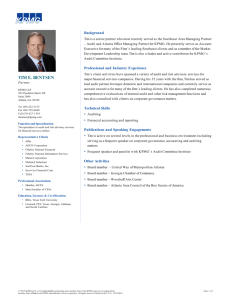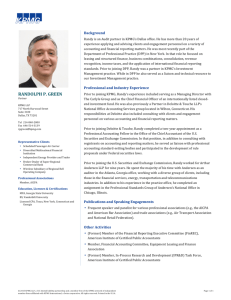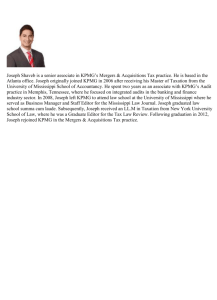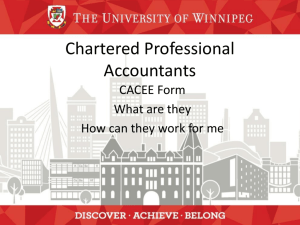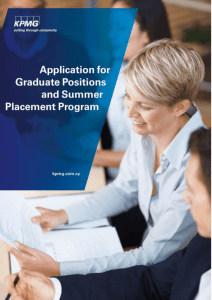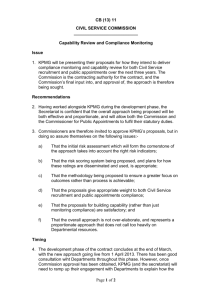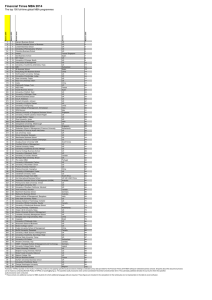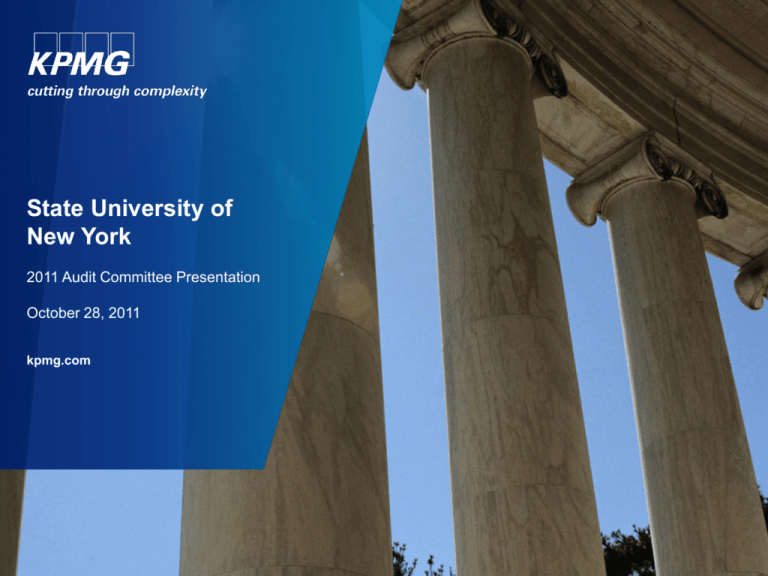
State University of
New York
2011 Audit Committee Presentation
October 28, 2011
kpmg.com
KPMG LLP
515 Broadway
Albany, NY 12207-2974
Telephone
Internet
+1 518 427 4600
www.us.kpmg.com
October 25, 2011
The Members of the Audit Committee
of the State University of New York:
This presentation has been prepared for our meeting with the State University of New York’s (SUNY) Audit Committee on October 28,
2011. Included are required communications of the scope and the preliminary results of our audit of SUNY’s financial statements as of and
for the year ended June 30, 2011. In addition, we have provided control enhancement observations, status of other deliverables and an
update on new accounting matters SUNY will face in future years.
We are pleased to have the opportunity to meet with the members of the Audit Committee to review this information and any other matters
of interest.
Very truly yours,
KPMG LLP
Jane H. Letts
Partner
KPMG LLP is a Delaware limited liability partnership,
the U.S. member firm of KPMG International Cooperative
(“KPMG International”), a Swiss entity.
Table of Contents
Executive Summary
Deliverables
KPMG Responsibilities Under GAAS
Consideration of Fraud
Summary of SUNY’s Components
Results of Substantive Testing to Date
Open Areas
Required Communications
Preliminary Management Letter Comments
Preliminary Audit Differences
Other Matters
© 2011 KPMG LLP, a Delaware limited liability partnership and the U.S. member firm of the KPMG network of independent
member firms affiliated with KPMG International Cooperative (“KPMG International”), a Swiss entity. All rights reserved.
71814NYO
3
Executive Summary
Financial Statements
Plan to issue an unqualified opinion for the year ended June 30, 2011, subject to completion of final audit procedures.
Significant disclosures for 2011:
–
Acquisition of the Long Island College Hospital, footnote 1.
–
As outlined in footnote 13 to the financial statements, several events subsequent to the financial statement date have
been disclosed.
Management Cooperation
We received full cooperation from management and had no disagreements on accounting, reporting or disclosure matters.
Internal Controls
We did not identify any material weaknesses or significant deficiencies in internal control over financial reporting.
We did identify certain control deficiencies and other observations that will be reported in a management letter.
Independence
To the best of our knowledge, there are no circumstances or relationships between KPMG and SUNY which would impair
our independence in reporting on SUNY’s financial statements.
Required Communications
Our responsibility for communicating with the Audit Committee, as required by our professional standards, is outlined in our
Required Communications, other than as contained in this report, we have no matters of significance to address with the
Audit Committee at this time.
© 2011 KPMG LLP, a Delaware limited liability partnership and the U.S. member firm of the KPMG network of independent
member firms affiliated with KPMG International Cooperative (“KPMG International”), a Swiss entity. All rights reserved.
71814NYO
4
Deliverables
Audit Plan, delivered in May, 2011
Auditors’ report on the basic financial statements
Auditors’ report on internal control and compliance
Management Letter
Letter to the Audit Committee fulfilling our requirements under SAS No. 114, Communications With Those Charged
With Governance
© 2011 KPMG LLP, a Delaware limited liability partnership and the U.S. member firm of the KPMG network of independent
member firms affiliated with KPMG International Cooperative (“KPMG International”), a Swiss entity. All rights reserved.
71814NYO
5
KPMG Responsibilities Under GAAS
Our Responsibilities under GAAS:
We have a responsibility to conduct our audit in accordance with generally accepted auditing standards. In carrying out this
responsibility, we planned and performed the audit to obtain reasonable assurance about whether the financial statements are
free of material misstatement, whether caused by error or fraud. Because of the nature of audit evidence and the
characteristics of fraud, we are to obtain reasonable, not absolute, assurance that material misstatements are detected. We
have no responsibility to plan and perform the audit to obtain reasonable assurance that misstatements, whether caused by
error or fraud, that are not material to the financial statements are detected.
In addition, in planning and performing our audit, we considered internal control over financial reporting in order to determine
our auditing procedures for the purpose of expressing our opinion on the financial statements. An audit does not include
examining the effectiveness of internal control and does not provide assurance on internal control. However, our internal
control testwork to date did not identify any deficiencies in internal control over financial reporting that we consider to be
material weaknesses.
© 2011 KPMG LLP, a Delaware limited liability partnership and the U.S. member firm of the KPMG network of independent
member firms affiliated with KPMG International Cooperative (“KPMG International”), a Swiss entity. All rights reserved.
71814NYO
6
Consideration of Fraud
“The auditor has a responsibility to plan and perform the audit to obtain reasonable assurance about
whether the financial statements are free of material misstatement, whether caused by error or fraud”
We addressed on our professional responsibility by executing the following procedures:
Management interviews and discussions including existing management fraud controls
Interviews with staff level and management employees
Review of journal entries, including large, unusual and non-recurring journal entries
Assess potential illegal acts or fraud allegations
Consideration of the following risks in the performance of our substantive procedures:
–
Internal pressures
–
Third party pressures
–
Related party transactions
–
Manual journal entries
–
Management bias
Based upon our inquiries and testing to date, no financial statement fraud came to our attention for the period
ending June 30, 2011.
© 2011 KPMG LLP, a Delaware limited liability partnership and the U.S. member firm of the KPMG network of independent
member firms affiliated with KPMG International Cooperative (“KPMG International”), a Swiss entity. All rights reserved.
71814NYO
7
Summary of SUNY’s Components
We considered our audit to be a “group audit” because of the inclusion of separate legal entities in SUNY’s
financial reporting entity. Below is a summary of our evaluation of SUNY’s components:
Component
Auditor
Audit Scope
SUNY Campuses and Health
Science Centers
KPMG
All SUNY Campuses and Health Science Centers are in scope. We have visited the
campuses listed in our audit plan and designed substantive audit procedures to
obtain sufficient and appropriate audit evidence covering transactions and amounts
reported by campuses and the health science centers.
The Research Foundation of State
University of New York (RF)
KPMG
We have placed reliance on the KPMG audit report issued over the RF's June 30,
2011 financial statements.
Alfred Ceramics (Statutory)
Bonadio
We have received audited financial statements, confirmed independence/objectivity
with auditor, reviewed other auditor's peer review report.
Cornell (Statutory)
PWC
We have received audited financial statements, confirmed independence/objectivity
with auditor, reviewed other auditor's peer review report.
State University Construction Fund
(Fund)
KPMG
We have placed reliance on the KPMG audit report issued over the Fund's March
31, 2011 financial statements. We have audited the adjusting entries posted by
SUNY to record capital assets based on the Fund's spending activity.
Auxiliary Service Corporations
Various
We have received audited financial statements, confirmed independence/objectivity
with auditor, reviewed other auditor's peer review report.
Campus Foundations – Discrete
Component Units
Various
We have received audited financial statements, confirmed independence/objectivity
with auditor, reviewed other auditor's peer review report.
N/A
Excluded from SUNY's financial reporting entity and therefore no procedures were
performed by KPMG.
Community Colleges
© 2011 KPMG LLP, a Delaware limited liability partnership and the U.S. member firm of the KPMG network of independent
member firms affiliated with KPMG International Cooperative (“KPMG International”), a Swiss entity. All rights reserved.
71814NYO
8
Results of Substantive Testing to Date
Key Risks
Significant Accounts
Complex financial reporting
process reliant on other
organizations
Investments, Capital Assets,
Payroll, Expenditures
Revenue recognition
Tuition and fees, grants,
hospitals and clinics
Audit Results to Date
We have documented and tested source documentation used in financial statement
preparation. We have confirmed the independence of other auditors.
We noted that the Controllers office has not received certain audited financial statements
used in their reporting process. See management letter comment.
We selected samples of revenue transactions and obtained source documentation. We
examined revenue transactions for compliance with SUNY and GAAP based revenue
recognition standards.
Tuition and patient revenues that
are uncollectible
Accounts receivable
No exceptions noted.
We reviewed collection history and receivable aging, and tested subsequent cash receipts.
We substantively tested key underlying data used to determine the adequacy of
allowances.
We believe account receivable balances are reasonably valued.
Assumptions and data underlying
actuarial calculations are invalid
or inaccurate
Actuarially determined
liabilities (including selfinsurance and OPEB
liabilities)
We utilized a KPMG actuary to assist us in assessing key assumptions and methodology.
We substantively tested key underlying data used to determine the liabilities and valuation.
We believe the OPEB valuation was reasonably stated.
Decentralized control
environment
All accounts and disclosures
Interview key operational personnel and evaluate competency. Test controls for reliance
over management review controls.
We believe controls at the campus level would be enhanced through the review and
consideration of service organization SAS 70 reports. See management letter comment.
We selected cash disbursements and traced transactions through to the appropriate
general ledger caption. We obtain underlying source documentation, including contract,
PO and invoice.
No exceptions noted.
We reviewed journal entries and topside adjustments, we interviewed personnel at SUNY
central and campuses.
We did not identify any fraud that impacted financial reporting.
Unsubstantiated disbursements
Fraud that could impact financial
reporting and presentation of
financial information
Operating expenses
All accounts and disclosures
© 2011 KPMG LLP, a Delaware limited liability partnership and the U.S. member firm of the KPMG network of independent
member firms affiliated with KPMG International Cooperative (“KPMG International”), a Swiss entity. All rights reserved.
71814NYO
9
Open Areas
SUNY’s acquisition of the Long Island College Hospital:
1. Examination of LICH’s final audited financial statements.
2. Review SUNY’s determination for inclusion of newly created separate legal corporations (LICH Holding Corporation and
Staffco) in SUNY’s reporting entity.
3. Determine the adequacy of footnote disclosures.
4. Review of legal documentation to determine:
–
Assets to be received by SUNY.
–
Assets to be received by LICH Holding Corporation.
–
Liabilities to be assumed by SUNY.
–
Assets and liabilities to be placed in legal trusts.
–
Future commitments and contingencies.
Completion Procedures:
1. Down to date inquiries
2. Final analytical procedures
3. Review of final financial statements, including KPMG’s national office.
4. Formalize conclusions on non-gaap accounting policies, passed audit differences and control deficiencies/observations.
5. Management representation letter
© 2011 KPMG LLP, a Delaware limited liability partnership and the U.S. member firm of the KPMG network of independent
member firms affiliated with KPMG International Cooperative (“KPMG International”), a Swiss entity. All rights reserved.
71814NYO
10
Required Communications
These communications are based on our audit testing to date and will be updated, as necessary, upon the completion of our audit.
Requirements Under SAS No. 114
Application to SUNY
Our Responsibility Under Professional Standards
The auditor should communicate to those charged with
governance the level of responsibility assumed under auditing
standards generally accepted in the United States of America
(GAAS) for matters such as internal control and whether the
financial statements are free of material misstatement.
Our primary responsibilities are:
‒ To conduct an independent audit of the financial statements in
accordance with GAAS and the standards applicable to financial audits
contained in Government Auditing Standards, issued by the Comptroller
General of the United States.
‒ To provide independent assurance to the Board of Trustees that the
financial statements prepared by management are presented fairly, in all
material respects, in conformity with U.S. generally accepted accounting
principles (GAAP).
In carrying out our responsibilities under GAAS, we obtained reasonable (but
not absolute) assurance that SUNY’s financial statements are free of material
misstatement and we intend issue an unqualified opinion thereon.
In addition, in planning and performing our financial statement audit, we
considered the SUNYs internal controls in order to determine our auditing
procedures for the purpose of expressing our opinion on the financial
statements. However, an audit does not include examining the effectiveness
of internal controls throughout SUNY and does not provide assurance on
internal controls for SUNY.
We also have a responsibility to communicate significant matters, if any,
related to the financial statement audit that are, in our professional judgment,
relevant to the responsibilities of the Board of Trustees in overseeing the
financial reporting process. However, we are not required to design
procedures for the purpose of identifying other matters to communicate to the
Board of Trustees.
© 2011 KPMG LLP, a Delaware limited liability partnership and the U.S. member firm of the KPMG network of independent
member firms affiliated with KPMG International Cooperative (“KPMG International”), a Swiss entity. All rights reserved.
71814NYO
11
Required Communications (continued)
Requirements Under SAS No. 114
Application to SUNY
Significant Accounting Policies
The auditor should determine that the Board of Trustees is
informed about:
The initial application of significant accounting policies or
changes in their application.
SUNY’s significant accounting policies are summarized in Note 1 to the
financial statements and represent policies prevalent to the financial position
and operations of SUNY.
During 2011, there were no transactions recorded for which there is a lack of
authoritative accounting guidance or consensus.
The methods used to account for significant and unusual
transactions, and the effect of significant accounting policies
in controversial or emerging areas for which there is a lack of
authoritative guidance or consensus.
Management Judgments and Accounting Estimates
Accounting estimates are an integral part of the financial
statements prepared by management and are based on
management’s current judgments. Certain accounting estimates
are particularly sensitive because of their significance to the
financial statements and because of the possibility that future
events affecting the estimates may differ from management’s
current judgments.
‒ Fair value of investments
‒ Post-retirement benefit obligations
‒ Accounts receivable realization
‒ Medical malpractice claims
The auditor should determine that the Board is informed about:
The process used by management in formulating accounting
estimates.
The basis for the auditor’s conclusions regarding the
reasonableness of those estimates.
Significant accounting estimates affecting SUNY’s financial statements
include the following:
We evaluated management’s significant judgments and estimates noted
above as part of our audit, and found them to be reasonable in the context of
the financial statements taken as a whole.
© 2011 KPMG LLP, a Delaware limited liability partnership and the U.S. member firm of the KPMG network of independent
member firms affiliated with KPMG International Cooperative (“KPMG International”), a Swiss entity. All rights reserved.
71814NYO
12
Required Communications (continued)
Requirements Under SAS No. 114
Application to SUNY
Audit Adjustments and Unadjusted Audit Differences
The auditor should inform the Board of Trustees about:
Adjustments arising from the audit that could, in the auditor’s
judgment, either individually or in the aggregate, have a
significant effect on the entity’s financial reporting process.
Passed audit adjustments aggregated by the auditor during
the current audit engagement (and pertaining to the latest
period presented) that were determined by management to be
immaterial, both individually and in the aggregate, to the
financial statements taken as a whole.
We identified no adjustments during the 2011 audit that could, in our
judgment, either individually or in the aggregate, have a significant effect on
SUNY’s financial statements.
Unadjusted audit differences identified do not have a significant impact on
SUNY’s net assets for the year ended June 30, 2011.
We will obtain written representation that management believes the effect of
the unadjusted audit differences are immaterial to the 2011 financial
statements.
Other Information in Documents Containing Audited Financial Statements
The auditor should discuss with the Board of Trustees our
responsibility for other information in documents containing
financial statements, any procedures performed, and the results
thereof.
Our responsibility for other information in documents containing SUNY’s
financial statements and our report thereon does not extend beyond the
financial information identified in our report, and we have no obligation to
perform any procedures to corroborate other information contained in these
documents.
Disagreements with Management
The auditor should discuss with the Board of Trustees any
disagreements with management, whether or not satisfactorily
resolved, about matters that individually or in the aggregate
could be significant to the entity’s financial statements or the
auditor’s report.
We had no such disagreements with SUNY’s management during our 2011
audit.
© 2011 KPMG LLP, a Delaware limited liability partnership and the U.S. member firm of the KPMG network of independent
member firms affiliated with KPMG International Cooperative (“KPMG International”), a Swiss entity. All rights reserved.
71814NYO
13
Required Communications (continued)
Requirements Under SAS No. 114
Application to SUNY
Management’s Consultation with Other Accountants
When the auditor is aware that management has consulted with
other accountants about auditing and accounting matters, the
auditor should discuss with the Board of Trustees his or her
views about such matters.
To the best of our knowledge, management has not consulted with or
obtained opinions (written or oral) from other independent accountants during
the past year concerning matters that were subject to the requirements of
SAS No. 50, Reports on the Application of Accounting Principles.
Major Issues Discussed with Management Prior to Retention
The auditor should discuss with the Board of Trustees any major
issues that were discussed with management in connection with
the initial or recurring retention of the auditor, including, among
other matters, any discussions regarding the application of
accounting principles and auditing standards.
We generally discuss a variety of matters, including the application of
accounting principles and auditing standards, with management each year.
However, these discussions occurred in the normal course of our
professional relationship, and our responses were not a condition to our
retention as SUNY’s auditors.
Significant Difficulties Encountered During the Audit
The auditor should inform the Board of Trustees of any serious
difficulties encountered in dealing with management during the
audit, such as unreasonable delays and timetables, unavailability
of personnel, and failure to provide information on a timely basis.
We encountered no difficulties in dealing with management during the
performance of our 2011 audit.
Material Written Communications
The auditor should ensure the Board is aware of all material
written communications between the auditor and management.
Material written communication between management and KPMG include:
‒ Engagement Letter; and
‒ Management Representation Letter
© 2011 KPMG LLP, a Delaware limited liability partnership and the U.S. member firm of the KPMG network of independent
member firms affiliated with KPMG International Cooperative (“KPMG International”), a Swiss entity. All rights reserved.
71814NYO
14
Required Communications (continued)
Requirements Under SAS No. 114
Application to SUNY
Independence
The auditor should communicate in writing, at least annually, all
independence-related relationships between the firm and the
client and provide confirmation that the firm is an independent
accountant with respect to the client.
We confirm we are independent accountants with respect to SUNY under all
relevant professional and regulatory standards.
© 2011 KPMG LLP, a Delaware limited liability partnership and the U.S. member firm of the KPMG network of independent
member firms affiliated with KPMG International Cooperative (“KPMG International”), a Swiss entity. All rights reserved.
71814NYO
15
Preliminary Management Letter Comments
Internal Control Definitions:
Material Weakness
A material weakness is a deficiency, or combination of deficiencies, in internal control, such that there is a
reasonable possibility that a material misstatement of the entity’s financial statements will not be prevented, or
detected and corrected on a timely basis.
Significant Deficiency
A significant deficiency is a deficiency, or a combination of deficiencies, in internal control over financial
reporting that is less severe than a material weakness, yet important enough to merit attention by those
charged with governance.
Control Deficiency
A control deficiency exists when the design or operation of a control does not allow management or
employees, in the normal course of performing their assigned functions, to prevent or detect and correct
misstatements on a timely basis.
Observation
Improvements to internal control or SUNY’s operations.
© 2011 KPMG LLP, a Delaware limited liability partnership and the U.S. member firm of the KPMG network of independent
member firms affiliated with KPMG International Cooperative (“KPMG International”), a Swiss entity. All rights reserved.
71814NYO
16
Preliminary Management Letter Comments (continued)
Control Deficiencies
Campus Cash Reconciliations – cash reconciliations were prepared for each account, however, we noted the existence
of stale reconciling items.
Review of SAS 70s – SUNY’s campuses utilize third party service organizations to perform student loan account
administration functions. We noted that certain SUNY campus personnel did not obtain and review service organization
SAS 70s.
User Access Rights Reviews – periodic user access reviews are currently not being performed.
System Backups – regular backups are performed, however, we were unable to determine the operating effectiveness of
this control as documentation is not retained beyond 3 months.
Testing of Disaster Recovery Plan – no disaster recovery tests were performed during the current year that could be
used to prove the recoverability of CAS Mainframe application.
Observations
Password Configurations – password settings are configured to enforce passwords of minimum 5 characters length. We
believe that at a minimum 8 characters should be present for a strong password.
Emergency Changes – follow the same process as normal program changes; however the policy and procedure document
for program changes does not specifically define emergency changes and the policies related to those changes.
Timeliness of Component Reporting – SUNY’s financial reporting process is dependent upon information supplied by
other organizations. In order to prepare SUNY’s June 30 th year-end financial statements, they require final audited financial
statements from the Long Island College Hospital. To date these audited statements have not been supplied to SUNY.
Additionally, The University Hospital of Brooklyn Foundation has not completed their financial audit for the period ending
July 31, 2010. These financial statements are required to be included in the Foundation financial statements of SUNY.
© 2011 KPMG LLP, a Delaware limited liability partnership and the U.S. member firm of the KPMG network of independent
member firms affiliated with KPMG International Cooperative (“KPMG International”), a Swiss entity. All rights reserved.
71814NYO
17
Preliminary Audit Differences
We have identified the following audit differences which we are currently in the process of quantifying:
Accrued Interest
SUNY records debt information supplied by DASNY at March 31, 2011. Accordingly, accrued interest expense is understated
for the 3-month period April 1st to June 30th. This error is expected to have an inconsequential impact to net assets as a
corresponding understatement in State appropriation revenue/receivable exists. There were no debt issuances or repayments
made during the April 1st to June 30th timeframe.
Capital Assets/Deposits with Trustees
SUNY records capital asset information for educational facilities and residence hall facilities as of March 31st. As a result,
capital spending from April 1st to June 30th is excluded from the financial statements. The offset to the understatement of
capital assets is an almost equal offset in deposits held with trustees. We expect this to have an inconsequential impact to net
assets.
Summer Tuition
SUNY defers all summer tuition. Accordingly, summer tuition related to the periods on or before June 30th has been
recognized in the subsequent reporting period. As this accounting policy is consistently applied year over year, the rollover
impact is expected to be inconsequential to net assets.
© 2011 KPMG LLP, a Delaware limited liability partnership and the U.S. member firm of the KPMG network of independent
member firms affiliated with KPMG International Cooperative (“KPMG International”), a Swiss entity. All rights reserved.
71814NYO
18
Other Matters
Consideration Items for the 2012 Audit:
–
Upstate Medical Center’s acquisition of Community General Hospital
–
The State-wide implementation of SFS.
–
New accounting standards:
GASB Statement No. 60, Accounting and Financial Reporting for Service Concession Arrangements
GASB Statement No. 61, The Financial Reporting Entity: Omnibus, an amendment of GASB Statement No. 14 and
No. 34
GASB Statement No. 62, Codification of Accounting and Financial Reporting Guidance Contained in Pre-November
30, 1989 FASB and AICPA Pronouncements
GASB Statement No. 63, Financial Reporting of Deferred Outflows of Resources, Deferred Inflows of Resources and
Net Position
© 2011 KPMG LLP, a Delaware limited liability partnership and the U.S. member firm of the KPMG network of independent
member firms affiliated with KPMG International Cooperative (“KPMG International”), a Swiss entity. All rights reserved.
71814NYO
19
© 2011 KPMG LLP, a Delaware limited liability partnership and
the U.S. member firm of the KPMG network of independent
member firms affiliated with KPMG International Cooperative
(“KPMG International”), a Swiss entity. All rights reserved.
71814NYO
The KPMG name, logo and “cutting through complexity” are
registered trademarks or trademarks of KPMG International.

